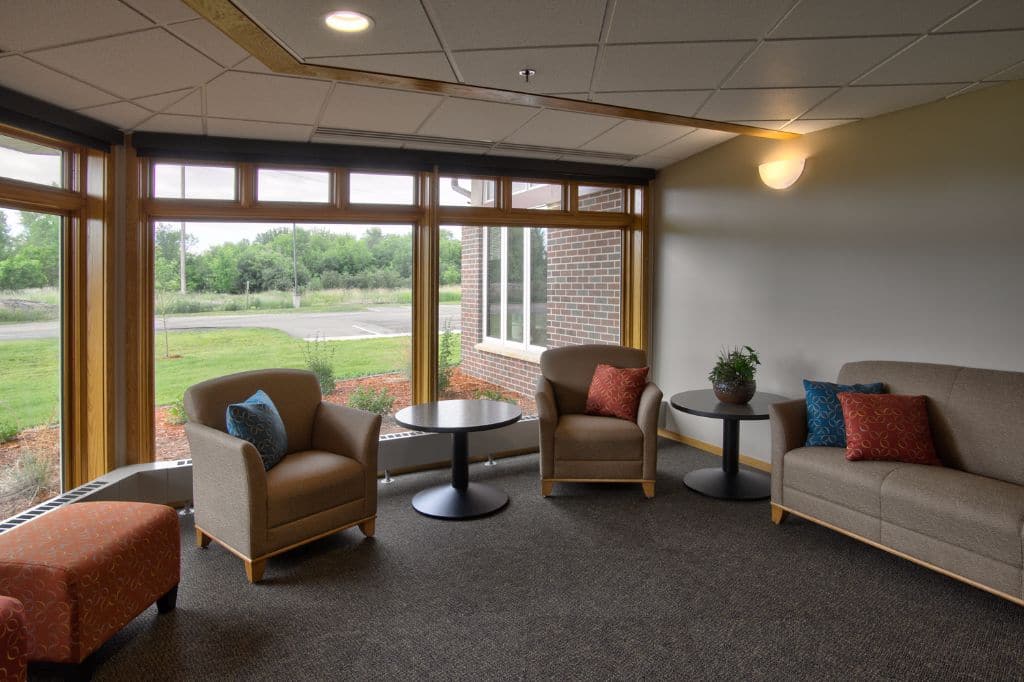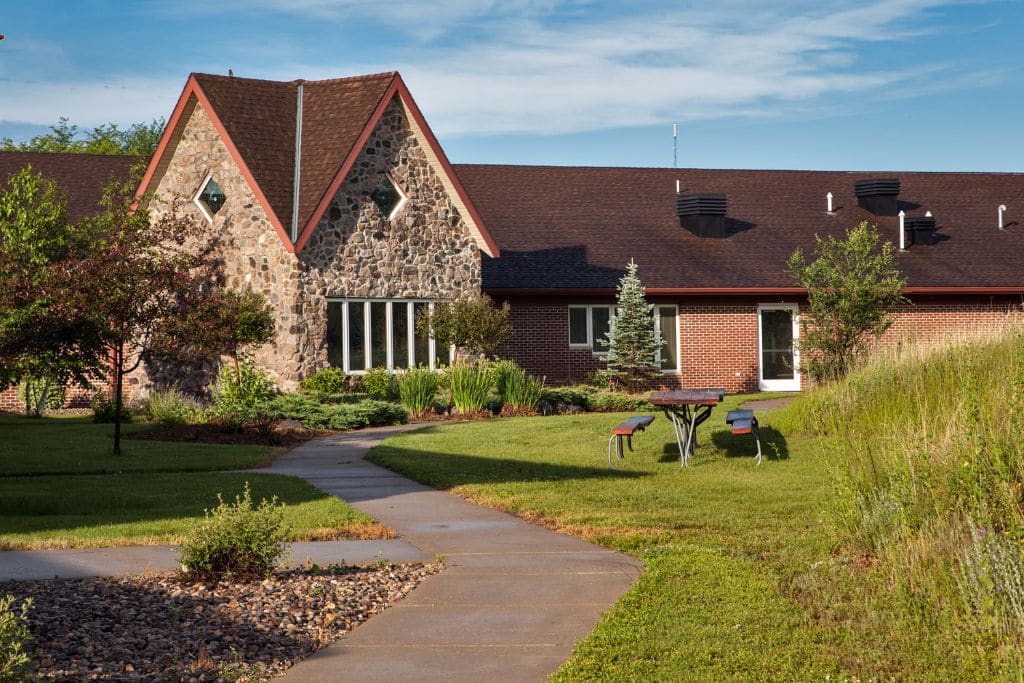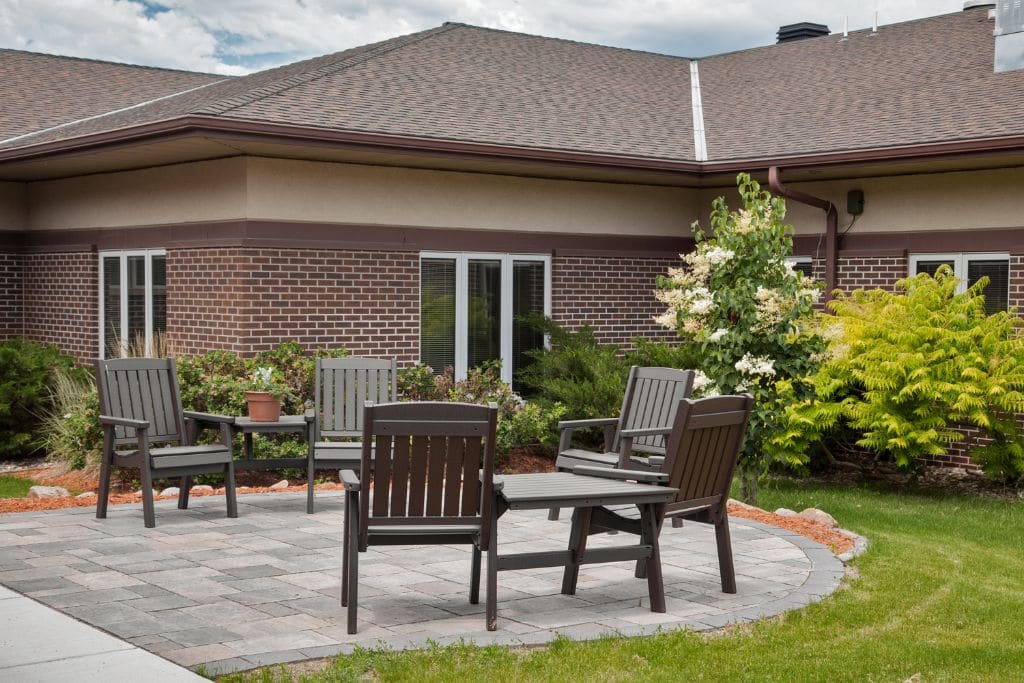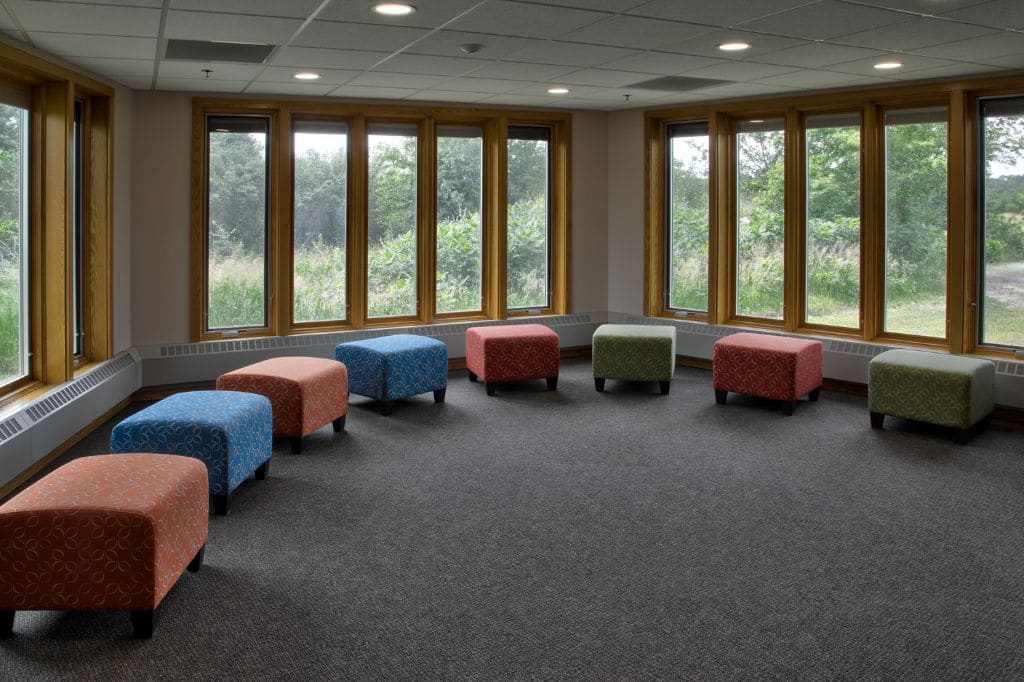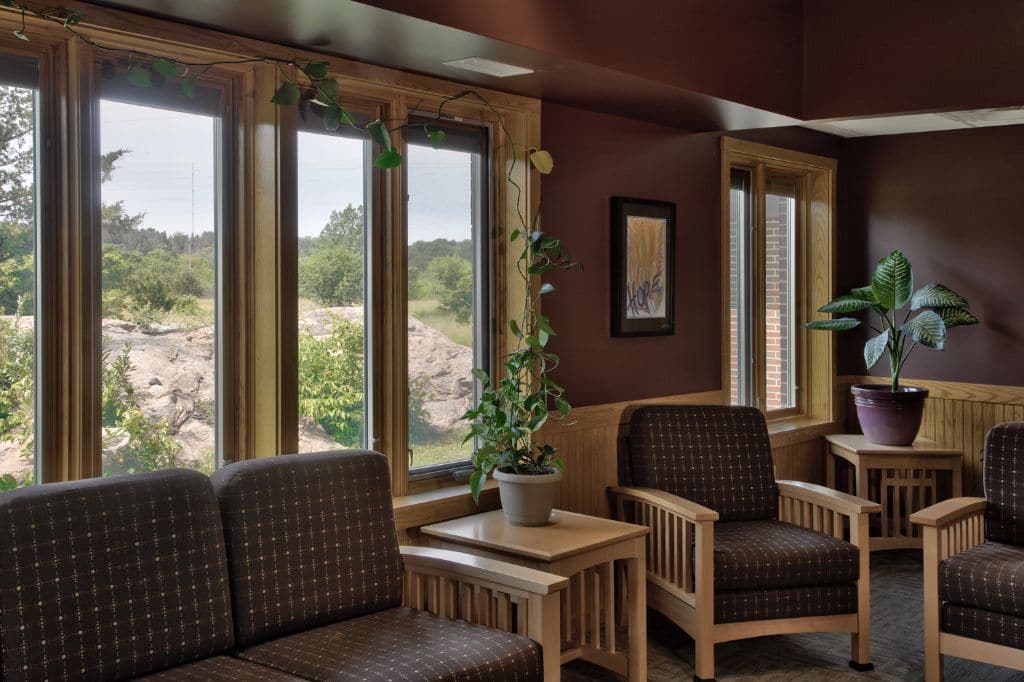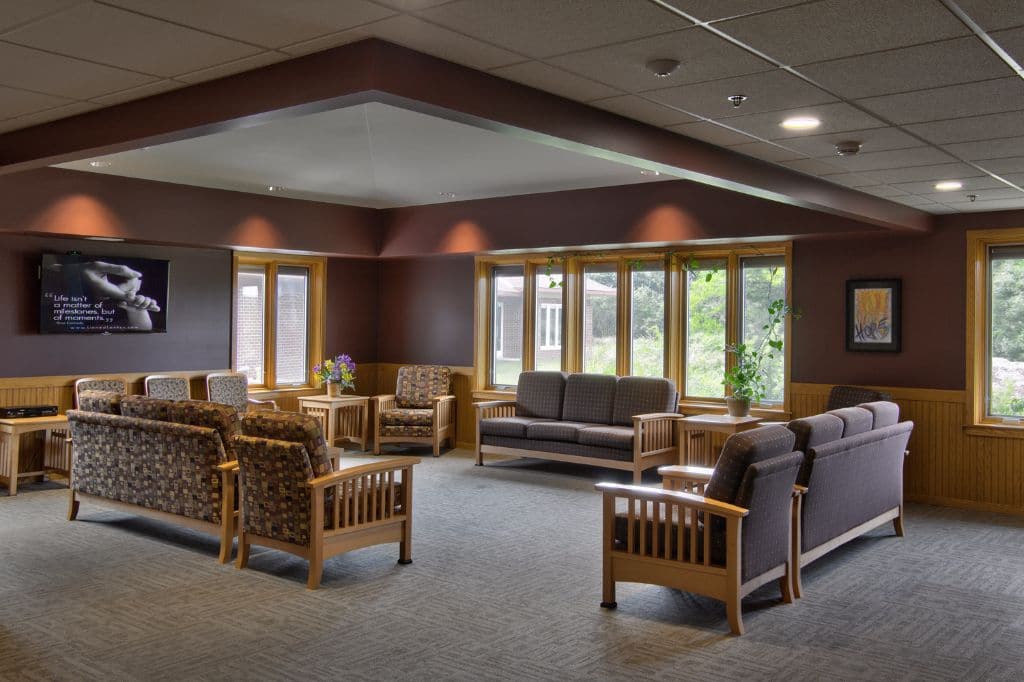Addiction treatment center patients are unique. They are often socially marginalized and stigmatized because of their addiction. Through the recovery process, they learn how to create a new life and a new world for themselves. Recovery is most successful when people feel good about themselves, when they are respected and valued. The experience at a recovery center is unique in a patient’s life. So, too, is the design of a successful treatment facility.
Mike Schiks, executive director at the treatment center Project Turnabout, elaborates, “The concept of therapeutic environment/community is critical to what we do. While it isn’t easily described, it’s about creating ‘a feel’ as much as creating a space. We wanted a place that communicates safety, respect, and hope to individuals and families who come to us for help. We need a setting conducive to people dropping their defenses, rediscovering their value, and making changes in their lives.”
While the needs of each patient—and treatment facility—are unique, there are a few design secrets that consistently improve treatment outcomes. Knowledge of these architectural best practices can help every health care leader make successful decisions when planning to build a treatment center.
Minnesota roots
We’ve identified best practices in treatment center design through 37 years of health care design experience. Our inspiration derives in part from our roots in Willmar, Minn., where the “Minnesota Model” of addiction treatment was pioneered in the 1950s. Since then, this model has been adopted and adapted around the world. Borrowing from the principles of Alcoholics Anonymous (AA), this approach provides residential treatment including lectures, open discussions, small group therapy, and peer interaction (Montvilo, 2012).
The Minnesota Model
Dan Anderson was a founder and primary innovator of the Minnesota Model at the Willmar State Hospital. He went on to expand and share this model during 30 years of work at the Hazelden Foundation in Center City, Minn. “The Minnesota Model represented a social reform movement that humanized the treatment of people addicted to alcohol and other drugs,” said Jerry Spicer, former Hazelden president and author of, “The Minnesota Model: The Evolution of the Multidisciplinary Approach to Addiction Recovery”. “Dan played a major role in transforming treatment wards from ‘snake pits’ into places where alcoholics and addicts could retain their dignity.”
Dignity was the foundation of Anderson’s work. Dignity is also the foundation of successfully designed treatment centers. Early in our practice, we were advised by Dr. Vince Mehmel, founding director of Woodland Centers’ community mental health program in Willmar, who said, “My job is half done if a facility conveys a sense of patients feeling good about themselves and a feeling that this place is successful.”
Keys to a successful recovery
Smart design plays a powerful role in creating the right “feel” for a therapeutic environment. It starts with big-picture visioning, then moves through phases of focus on greater degrees of detail.
Attention to three specific design features have a particular influence on how patients feel in a treatment center: 1) scale, 2) homelike features, and 3) natural beauty.
Scale
Scale is an architectural term that describes both the size of spaces as well as the way spaces relate to each other. Attention to scale can have extraordinary effects on how people feel in their physical surroundings. For example, high ceilings in a lobby can make a space feel grand and impressive, while lower ceilings can make a lobby feel more inviting and safe. Very large spaces can feel majestic but impersonal; very small spaces can feel cozy but claustrophobic. Decisions about scale need to be appropriate for the intended uses of each space and its surroundings.
In treatment centers it’s important that both outdoor and indoor spaces are designed to emphasize a human, residential scale. This encourages the kind of peer-to-peer and peer-to-staff connections that lead to optimal recovery outcomes.
Here are some examples of how this can be accomplished:
- Regardless of the total size and population of a treatment facility, patients are accommodated in residentially-scaled units or “pods” of 15 to 25 residents per unit. Each of these pods shares therapeutic, social, and dining times with only their fellow pod This encourages bonds and camaraderie to form that lead to optimal treatment outcomes.
- Group therapy rooms are designed for a maximum of 10 to 20 people. This group sizing intensifies the relationships that are important for recovery. Patients get to know members of their group very closely.
- Circulation (how people move through a building) and scheduling are designed to allow each house to move between dining, activity, and recreation areas with minimal interaction with residents from other houses—this helps maintain the residential scale of the facility.
Homelike features
Thoughtful attention needs to be paid to creating a homelike environment. Many addiction treatment patients have lost their original home and have been living without the social controls that come with residing in a home. Through appropriate use of scale and finishes, a homelike, residential feeling aids with the recovery process.
For example:
- Patient bedrooms can be designed to be comfortable, spacious, and homelike—conveying the message that patients are respected and cared for.
- Bedrooms that have low half-walls between beds maintain a sense of privacy without creating isolation.
- Personal pinboards are provided next to each bed so patients can hang photos of loved ones and mementos of home. These are generally comforting; they also serve as a reminder of why a resident may be working on recovery, e.g., for their children.
- Double and triple occupancy bedrooms support the intention that residents should spend waking hours with others in group areas of the center. Living units are designed to encourage patients to spend free time working on their addiction in small groups of other residents, rather than isolating themselves in bedrooms. It’s natural for people to want to retreat into themselves; however, successful treatment requires that people engage with other residents and with staff.
- Overall a homey, comfortable atmosphere is provided, with areas for conversation and personal reflection. This design concept allows clients to support one another in their recovery process.
Natural beauty
The healing effects of nature are well known. Knowledge of the stress-relieving benefits of access to nature in health care environments dates as far back as the earliest large cities in Persia, China, and Greece (Velarde, Fry, & Tveit, “Health Effects of Viewing Landscapes,” 2007). Incorporating this knowledge into treatment center design has a significant positive affect on treatment outcomes.
Calming interaction with the natural world can be provided in both interior and exterior portions of treatment centers. It’s important to include lots of windows to bring the outside in, and create pleasant spaces for small group interaction or areas for residents and their families to meet. Whenever possible, treatment centers should also provide outdoor environments for quiet, individual reflection—e.g., hiking trails, labyrinths, or benches overlooking pleasant landscapes.
Influencing a patient’s new reality
An important part of treatment is changing a patients’ sense of reality while they are in treatment. A former client and treatment center administrator phrased his goal as, “A Whole New World.” Through the design of a center’s physical environment and treatment program, the goal is to empower clients to envision and create a new way of living.
Once this experience has been achieved through treatment, it’s important that patients are able to easily recall the memories of their treatment experience. This memorability helps them reintegrate into the bigger world with their newly-learned skills.
Several design principles—contrast, fellowship, and values—assist in building memorability and a new reality.
Contrast
The treatment environment should contrast with what patients were accustomed to before checking in. The features described earlier (including warm, homelike settings with an emphasis on natural beauty) provide this contrast for many residents, whose reality before treatment is often less comfortable.
Fellowship
A powerful impact can be made by serving meals in a family-style environment that promotes fellowship. In contrast to an institutional feeling or eating alone in front of a TV, family-scaled dining establishes memories of friendship, comfort, and security. The sense of fellowship created through family-style meals can then be carried through the rest of each day’s activities.
Views
As described earlier, views of natural beauty are an important part of a healing environment. The views in a treatment center should be designed to be unique and memorable and will help patients remember what they learned in treatment.
Conclusion
Addiction is a phenomenon that has been fundamentally reframed in the past century. Through the work of pioneering professionals and dedicated recovering addicts, the “Minnesota Model” and similar approaches have moved our culture from the vilification of addicts towards the recognition of their dignity.
The most effective treatment centers are those that empower people to rediscover their dignity. Successful treatment centers make use of several architectural best practices—or “secrets”—including attention to scale, homelike features, and natural beauty. Use of these design practices results in a treatment experience that is memorable enough to propel patients into post-treatment success.
Originally published in the June, 2016 issue of Minnesota Physician (pp. 30-32).

